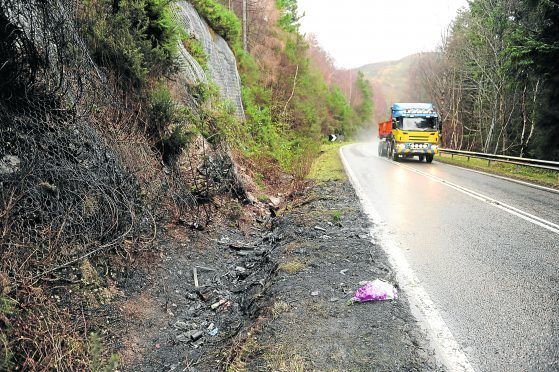A sheriff has found no evidence that a north man trapped in the flame-filled cab of his fuel tanker would have survived if a fire extinguisher had been working.
Steven Mitchell’s right leg became caught in wreckage after the vehicle crashed into a rock face off the A835 Inverness to Ullapoool road, causing the vehicle to topple on its side.
At a fatal accident inquiry Sheriff Gordon Fleetwood found the most likely cause of the subsequent fire was damaged wiring, with the blaze accelerated by the presence of diesel.
The incident happened near Ullapool on December 19, 2015, at about 12.50pm.
The inquiry heard how motorist and fellow lorry driver, John Bellshaw, attempted to enter the lorry cab to save the 48-year-old – but the fire spread quickly and forced him to retreat.
Mr Mitchell, from Inverness, was passed a fire extinguisher through a gap in the windscreen to fight back the flames, and motorists tried to use a second device but this did not work.
One of the first witnesses on the scene, Robin Forrest, told the inquiry that he felt if the fire extinguisher had been working, the driver “may have had a chance of surviving” until more help came.
But Sheriff Fleetwood said he could not accept this “as likely or feasible given the power of the fire, the speed at which it developed and the extent to which it had taken hold” when the fire service arrived.
He added: “By the time the SFRS attended, about 10 minutes after the alarm was raised, the blaze was out of control and Mr Mitchell certainly dead, the evidence was that anyone in the cab could not still be alive.
“I am unable to come to the conclusion that Mr Mitchell was likely to have survived had the rescuers had a working fire extinguisher to hand.”
Evidence from fire safety engineer, Neil MacGregor, suggested the fire extinguishers had become “depressurised” as a result of their safety pins being removed at some point, and the pins had been replaced by someone unknown, evidence which Sheriff Fleetwood agreed with.
Sheriff Fleetwood added: “Highland Fuels Ltd had a system in place to ensure that fire extinguishers met legal requirements and were inspected regularly.
“There was an annual inspection by a representative of the manufacturer. More importantly the daily checks which the drivers of Highland Fuels Ltd’s drivers were required to carry out included checking the fire extinguishers. There was evidence this was routinely done. There was evidence that training the drivers had included checking these devices.
“There was a system in place for replacing damaged or inoperative devices.”










